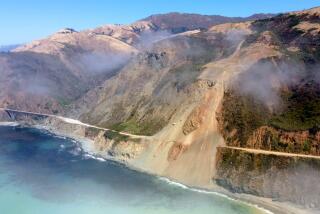Keeping Our Arteries Open
- Share via
The San Diego Freeway is a central lifeline of Orange County, a road seemingly always being widened or torn up and repaired, but a necessity for thousands of people to get from here to there.
For more than half a year, the freeway has been taken over at night by construction crews that have been given the important job of extending the life of the road for another few decades.
It’s vital, dangerous work, a $12-million project that Caltrans needs to be sure is done correctly. The agency should take pains to avoid the type of situation it finds itself in on the San Joaquin Hills toll road, where drain filters have failed to clean contaminated storm water. The water then runs off the highway and into local watersheds.
On the San Diego Freeway, Caltrans is embedding 18-inch-long metal dowels under pavement stretching for 10 miles through Costa Mesa and Irvine. The dowels are intended to prevent the pavement from buckling under the weight of the thousands of cars whizzing--or crawling--by each day. The process known as dowel-bar retrofitting is billed as cheaper and more efficient than replacing old concrete pavement.
Retrofitting once was considered too expensive and not too effective. But experts say a machine that can cut deep symmetrical grooves in the pavement lets jackhammers follow along and more easily dig out the concrete. That establishes trenches, which are sandblasted before steel bars are installed. Chalk one up to ingenuity.
Three years ago, Caltrans decided to try the technique after seeing Washington state use it successfully and after a brief experiment on Interstate 80 near Colfax in Northern California. The agency rightly decided on more testing, picking five sites to use the machine, known as a slotter. One site was the San Diego Freeway near John Wayne Airport.
Last year, convinced the technique was feasible, Caltrans retrofitted a stretch of road in Pomona and then moved to the Costa Mesa and Irvine sector, where the concrete is 35 years old. That means it has lasted five to 10 years longer than it was designed to endure, officials said.
A federal official said the retrofitting is the best concrete pavement rehabilitation technique to be implemented in many years and is likely to be used across the country rather than ripping out all pavement and laying fresh concrete.
Caltrans said the crew it hired works from 11 p.m. to 5 a.m. seven nights a week. Workers say their jobs would be easier if motorists would pay attention, slow down when they see the construction signs and give a wider berth to the crews. Because many motorists are not careful, all lanes but one get shut while construction is underway.
Farther south on the freeway is the connection to the San Joaquin Hills toll road, which runs from Newport Beach to San Juan Capistrano. In that approximately 20-mile stretch, the road passes through several watersheds.
Caltrans assumed responsibility for operating and maintaining the road five years ago. That includes ensuring that the drains work properly. Unfortunately, they have not.
A Caltrans study found that although the drain filtering systems were thought to be suitable when the road was being designed and constructed, that opinion was wrong. The filters allow sediment and pollutants to build up on top, blocking the drain. Officials of the San Joaquin Hills Transportation Corridor Agency blame Caltrans, saying the system was fine, but the agency’s maintenance has been poor.
Another toll road, the Foothill, is now being investigated by state water officials after a complaint by an environmental activist that the agency is not controlling runoff as much as it could.
Caltrans has promised to fix the dozens of filters on the San Joaquin Hills toll road. It should--quickly. The San Diego Regional Water Quality Control Board already has ordered the agency to live up to its permit to discharge water from the toll road. Caltrans has to ensure that it keeps the roads in repair without harming the environment.
More to Read
Sign up for Essential California
The most important California stories and recommendations in your inbox every morning.
You may occasionally receive promotional content from the Los Angeles Times.










